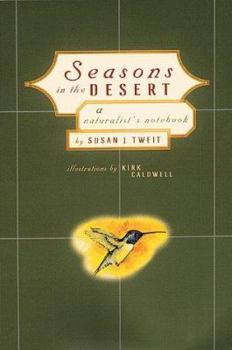Seasons in the Desert
Select Format
Select Condition 
Book Overview
An esteemed nature writer combines witty prose with natural history and ecological fact to examine and expose the lives and ways of forty plants and animals of the American Southwest. IP. This description may be from another edition of this product.
Format:Hardcover
Language:English
ISBN:0811816850
ISBN13:9780811816854
Release Date:January 1998
Publisher:Chronicle Books (CA)
Length:224 Pages
Weight:1.25 lbs.
Dimensions:1.1" x 5.4" x 8.1"
Customer Reviews
1 rating
Susan Tweit reveals the abundance of life in deserts.
Published by Thriftbooks.com User , 25 years ago
The American Heritage Dictionary defines a desert as "a region rendered barren or partially barren by environmental extremes." Susan Tweit obviously does not agree with the writers at American Heritage. With her book in hand, readers will come to the same conclusion. Consider a desert pothole, one of those shallow, soil-filled pits in sandstone. At first glance they seem lifeless, but after a desert rain supplies the water, eggs and larvae that have lay dormant in the soil for months or years burst into life. Within hours animals as exotic as tadpole shrimp, which resemble miniature horseshoe crabs, and their crustacean cousins, fairy shrimp, begin to ply the pool. Other pothole denizens may include microscopic mites, that only occur in South Africa and the desert southwest, or spadefoot toads, which have been buried two feet deep in soil near the pothole waiting for the revivifying moisture. During the ephemeral life of the pothole the animals spend most of their time feeding and breeding. As the water evaporates the frenzy continues with cannibalism a common occurrence. Before the soil dries out again, though, eggs and larvae will settle down into the mud to wait for the next rain storm. And the next miracle of the pothole.In her new collection of essays, Susan Tweit circumvents the sterile dictionary definition by exploring 40 desert lives as diverse as rattlesnakes, fairy shrimp, Christmas cholla, and screwbean mesquite. The 900-word-stories are told with a naturalist's sensibility and care for the natural world. "I think of these desert characters as my relatives, in the sense that all life is kin." She does not, however, preach or anthropomorphize. Nor does she slip into new-age polemics.The book is organized by season, starting with spring. Each essay focuses on one animal or plant but also interweaves a kaleidoscope of pollinators, predators, scientists and explorers. The stories paint a full picture not just of the star of the story, but of the lives that rev! olve around it. Tweit also adds voices of researchers and writers who offer another level of insight into these desert lives. Tweit's language conveys her intimate knowledge and deep care for the flora and fauna she describes. She concludes her essay on Couch's spadefoot toad with: "To hear the swelling nighttime chorus of spadefoot toads is to know joy. When I hear sapitos [the Spanish term], I am overcome with the urge to dance barefoot in puddles, ... to celebrate the return of water to this parched land." In the early 1900s the great naturalist John Burroughs wrote "Indeed, nature-study, as it appeals to us in books, fails of its chief end if it does not send us to nature itself." Susan Tweit's new book admirably meets Burrough's standard-seducing its readers to go out and make their own discoveries in the desert.




